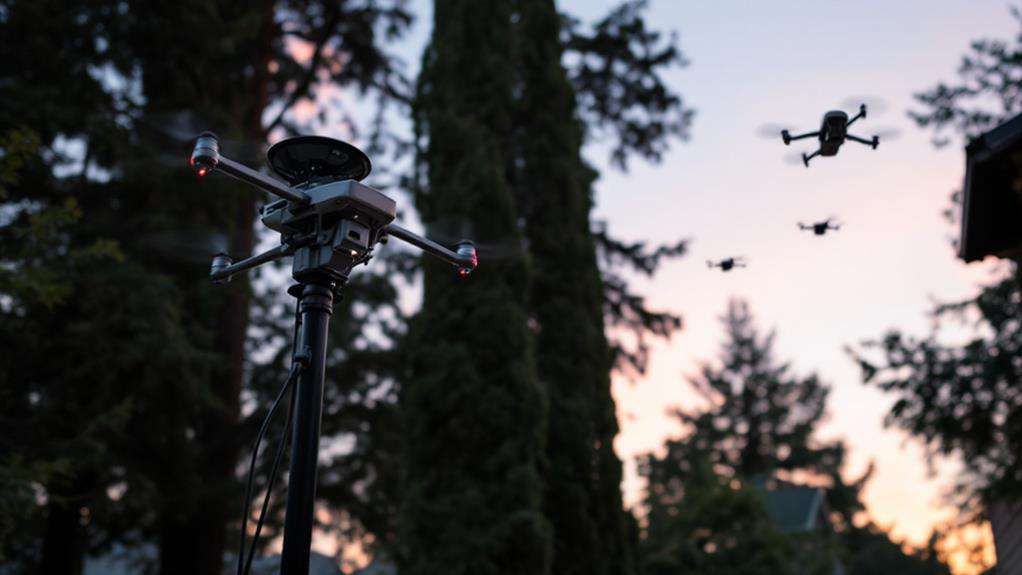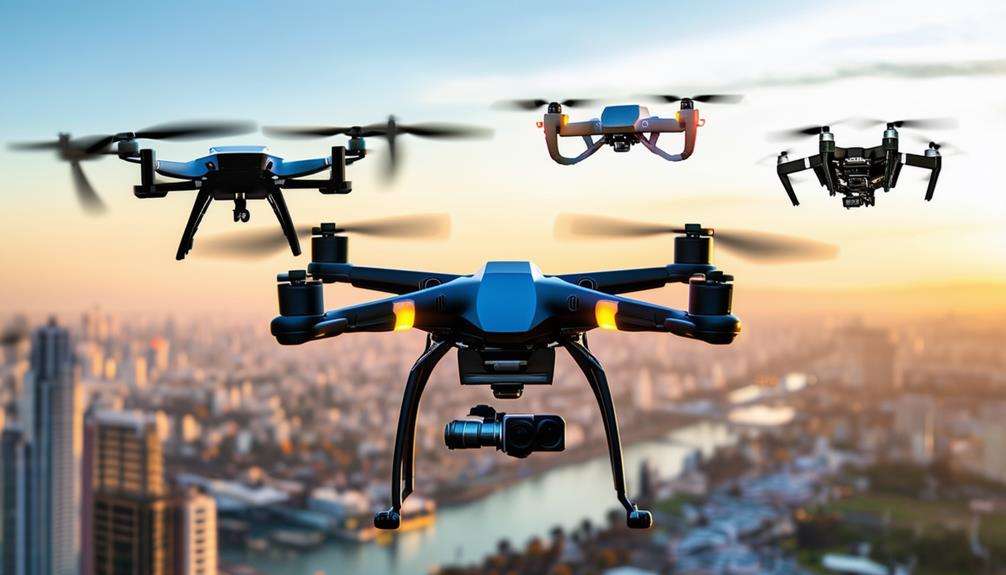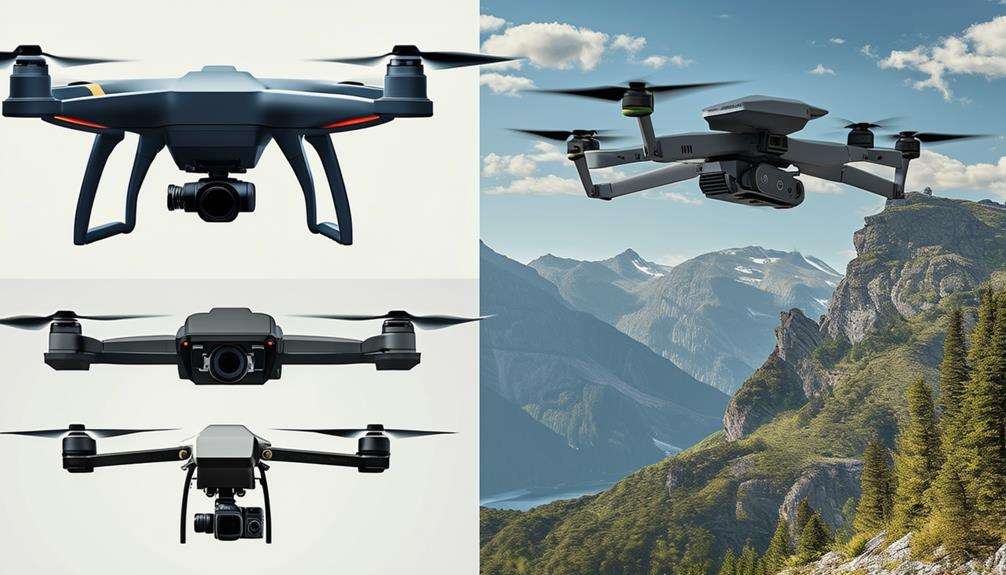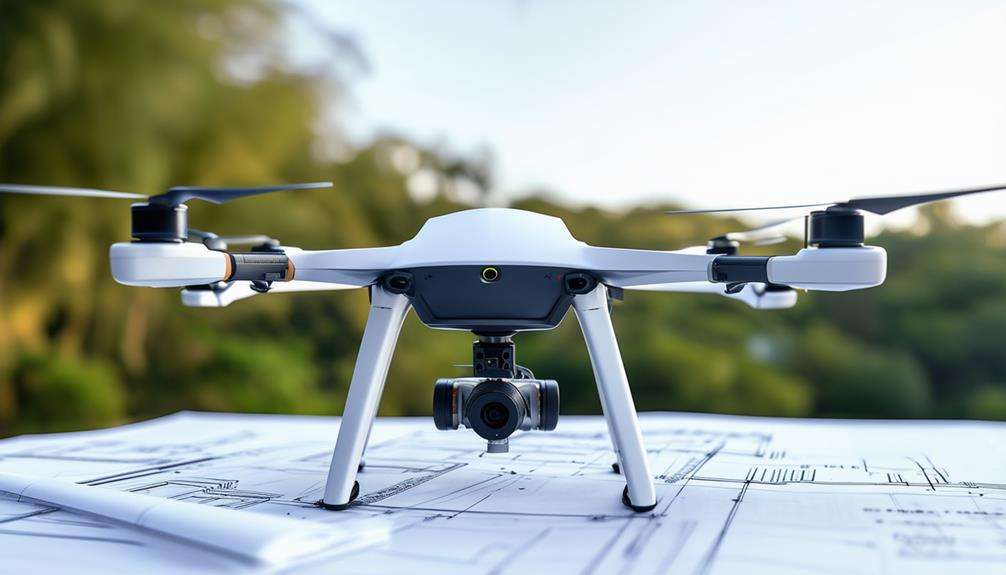A Brief History of Drones: From Military to Commercial Use
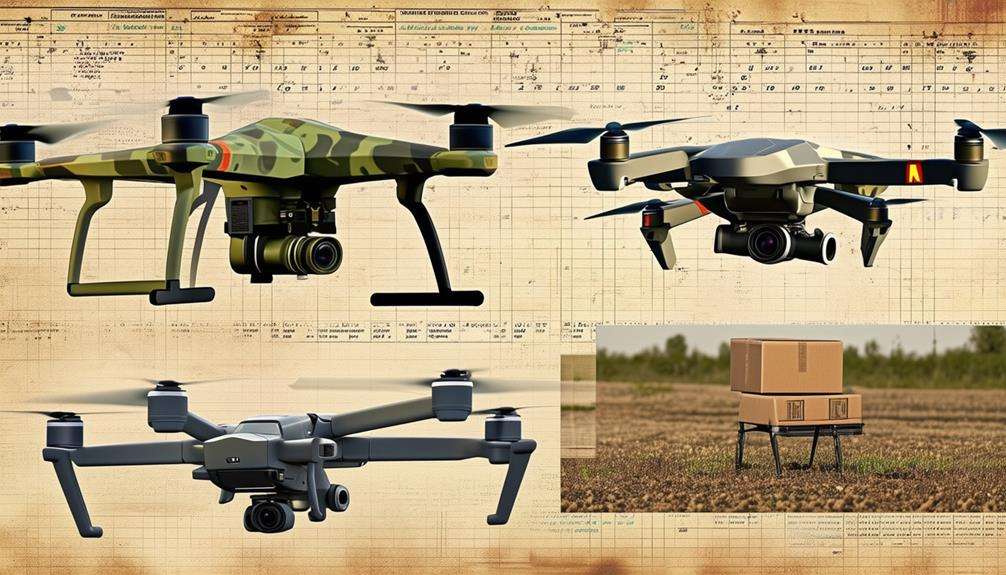
Explore the evolution of drones, from their early military applications to their significant role in modern commerce. Early innovations like the Ruston Proctor Aerial Target during World War I set the stage for future developments. By the Cold War and Vietnam War eras, drones had become more advanced, extending their utility beyond combat scenarios.
Today, drones are indispensable in sectors such as agriculture, oil, and wind energy. Curious about how these transformations occurred and what the future holds for drone technology? Let's delve into this fascinating journey together.
Early Military Drones
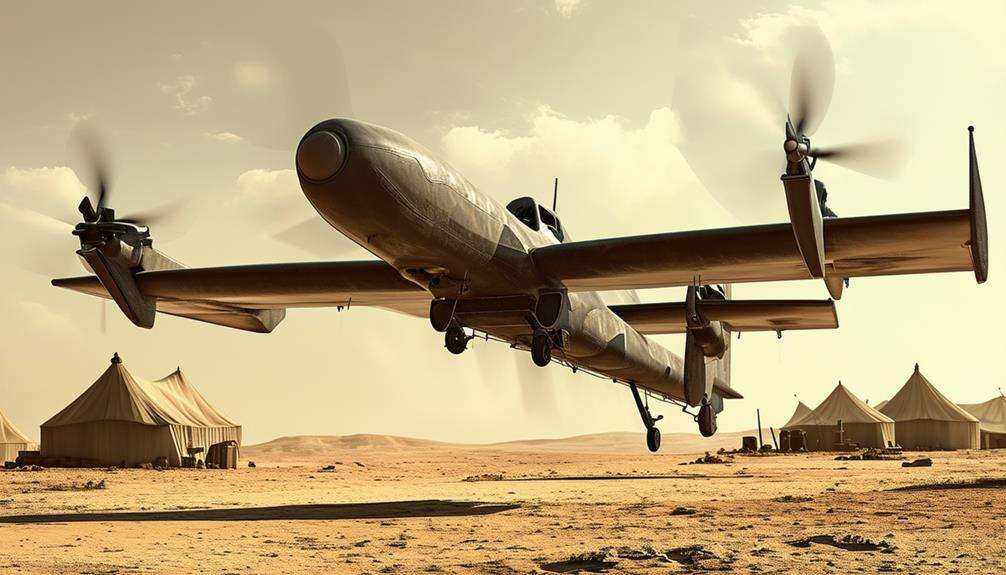
In the early 20th century, military drones like the Ruston Proctor Aerial Target and the Kettering Bug marked significant advancements in unmanned aerial technology, particularly during World War I and World War II. The Ruston Proctor Aerial Target, developed in the 1910s, was one of the earliest radio-controlled aircraft and was primarily used for target practice to improve anti-aircraft artillery accuracy.
The Kettering Bug, introduced towards the end of World War I, was an early cruise missile designed to carry a payload of explosives to strike targets beyond the reach of conventional artillery. Although it saw limited action, the Kettering Bug demonstrated the potential for drones in offensive operations.
During World War II, the use of drones expanded to include reconnaissance missions, providing valuable intelligence without risking pilot lives. These early drones laid the groundwork for modern UAVs, proving their worth in both reconnaissance and target practice roles. The evolution of military drones during this period underscored their growing significance in military strategy and operations.
World War I Innovations
During World War I, the foundation of drone technology can be traced back to early reconnaissance missions and the development of initial drone prototypes. The British pioneered radio-controlled aircraft such as the Aerial Target and Queen Bee for training purposes. These advancements established the basis for contemporary drone technology.
Early Reconnaissance Efforts
Pioneering the use of unmanned aircraft, the British developed the Aerial Target and Queen Bee as early radio-controlled planes for training and target practice during World War I. These initial efforts laid the groundwork for future advancements in drone technology.
The Aerial Target, one of the first radio-controlled aircraft, was primarily used as a target for training anti-aircraft gunners. The Queen Bee, an evolution of the Aerial Target, offered a more sophisticated platform for similar purposes.
These early drones enabled safer and more efficient training exercises. While initially designed for practice, their potential for reconnaissance and intelligence gathering became evident. As the technology evolved, drones were increasingly employed for artillery spotting, providing critical data to inform battlefield strategies.
Initial Drone Prototypes
World War I innovations in drone technology highlighted the British military's ingenuity in developing early unmanned aircraft. Prototypes like the Aerial Target and Queen Bee were groundbreaking, serving primarily for training and target practice. These early models laid the groundwork for future advancements in unmanned aviation.
As you explore further, you'll find some astonishing milestones:
- Endurance Record: In 1946, a drone based on the B-17 Flying Fortress airframe set an endurance record, demonstrating the potential for long-duration flights.
- Seaslug Trials: The Canberra U Mk 10 jet plane, converted into a pilotless drone in 1961, played a crucial role in target location during the Seaslug guided missile trials.
- Surveillance Capabilities: The Midge Surveillance Drone, with its rocket-powered flight and pre-programmed paths, revolutionized aerial reconnaissance for the British Army.
These early drones were more than just prototypes; they were instrumental in shaping modern military strategy. Reconnaissance drones later saw action in the Gulf War, providing essential intelligence and artillery spotting. Each innovation built upon the last, pushing the boundaries of what unmanned aircraft could achieve.
Developments in World War II
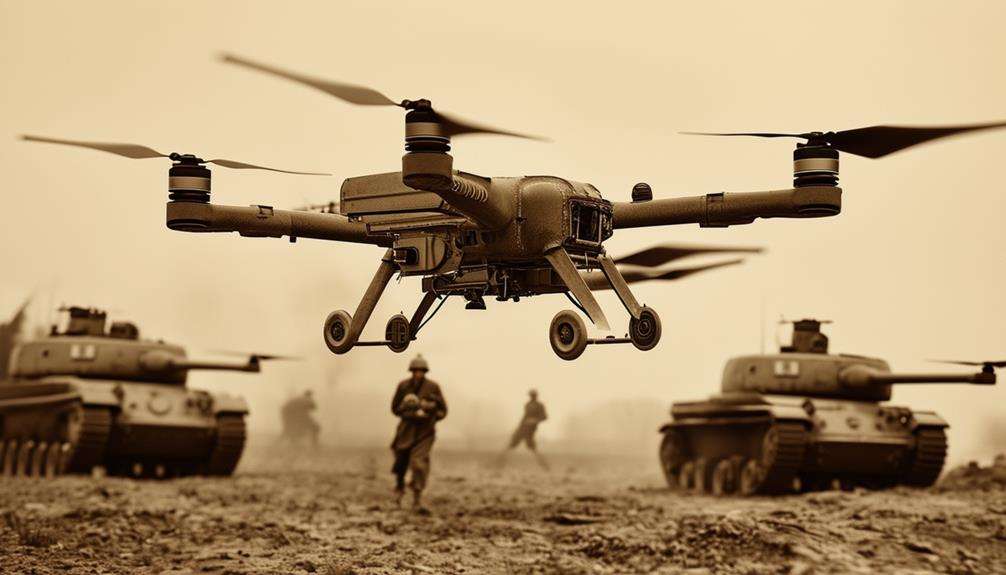
During World War II, early drone innovations significantly impacted military tactics. The British Army's use of the Midge Surveillance Drone for reconnaissance and the Queen Bee for target practice marked pivotal advancements in drone technology. These developments laid the groundwork for modern military drones.
Early Drone Innovations
Harnessing radio control technology, the British military introduced the Queen Bee drone in World War II for target practice and training, marking a notable leap in early drone innovations. This radio-controlled aircraft was a pioneering step in the development of military drones, providing pilots with realistic moving targets and enhancing their training and accuracy.
The Queen Bee set the stage for more sophisticated drone technology. By the 1960s, the Canberra U Mk 10 jet plane was transformed into a pilotless drone for guided missile trials in the Seaslug program. This innovation showcased the versatility of drones in military applications, ranging from target practice to complex missions.
During World War II, reconnaissance drones became invaluable. The Midge Surveillance Drone, featuring rocket-powered flight and pre-programmed paths, was used for aerial reconnaissance. These early innovations allowed for real-time intelligence gathering, significantly impacting military strategy.
Consider the emotional impact of these advancements:
- Increased pilot safety: Reducing the risk to human life during training and reconnaissance missions.
- Enhanced military strategy: Providing real-time intelligence for better decision-making.
- Technological breakthroughs: Paving the way for modern drone technology.
Military Tactical Advancements
During World War II, military tactical advancements saw the deployment of more sophisticated and versatile drones for combat and intelligence purposes. The British military introduced the Queen Bee, a radio-controlled aircraft, which served as a target drone for training anti-aircraft gunners. This early use of Unmanned Aerial Vehicles (UAVs) was pivotal in preparing forces for actual combat scenarios.
Drones like the Queen Bee quickly evolved beyond target practice. These vehicles developed into more complex systems capable of diverse tasks, including reconnaissance. The term 'spy plane' began to take shape as UAVs were adapted for intelligence gathering, enabling military forces to observe enemy movements without risking pilot lives.
World War II marked a significant period where UAVs advanced from experimental devices to integral components of military strategy. As the technology evolved, these drones became indispensable tools for both offensive and defensive operations. By the end of the War, the groundwork had been laid for future advancements, ensuring that Unmanned Aerial Vehicles would continue to play a pivotal role in military tactics and operations.
Cold War Era Advances
During the Cold War, drone technology advanced significantly, becoming essential tools for military intelligence and reconnaissance. These drones were equipped with advanced sensors, cameras, and sophisticated communication systems, enabling real-time data transmission and extensive surveillance missions. Their versatility extended to target practice and testing, demonstrating their multifaceted military applications.
Key impacts of Cold War-era drone advancements include:
- Enhanced Surveillance: Drones covertly monitored enemy activities, gathering valuable intelligence.
- Real-time Communication: Advanced systems facilitated immediate data sharing for informed decision-making and rapid response.
- Versatile Applications: Beyond reconnaissance, drones were extensively used for target practice and testing.
The innovations of this period transformed drones from simple remote-controlled aircraft into sophisticated tools integral to modern warfare and intelligence, laying the groundwork for their widespread use in both military and commercial sectors.
The Vietnam War Impact
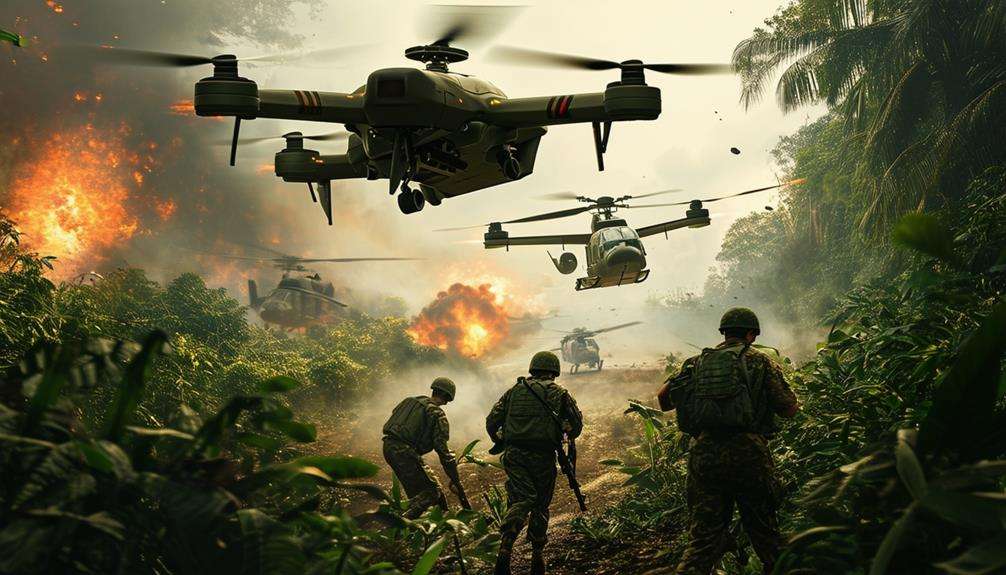
During the Vietnam War, drone technology advanced significantly with the introduction of the Ryan Model 147, marking the first major deployment of drones for reconnaissance missions. The Ryan Model 147 flew over enemy territory, gathering crucial intelligence without risking pilot lives. These drones served multiple purposes: reconnaissance, acting as decoys, launching missiles, and even participating in psychological operations.
By the 1980s, drones like the RQ-2 Pioneer emerged through the Pioneer UAV Program, a U.S.-Israeli collaboration. This era built on lessons from the Vietnam War, proving that drones could be reliable and cost-effective. The Pioneer UAV Program marked a significant shift in the military's perception of drones, paving the way for their widespread use.
Innovations during the Vietnam War also included advancements in assault drones and explorations into alternative power sources. Experiments with solar power to extend drone flight times were conducted even then. This period laid the foundation for the sophisticated drones seen today, bridging the gap between early military applications and modern technology.
Rise of Commercial Drones
Commercial drones have revolutionized various industries by providing cost-effective and efficient solutions for tasks that once required significant human effort and resources. The FAA's issuance of the first commercial drone permits in 2006 opened new possibilities for businesses. This shift has profoundly impacted sectors such as agriculture, oil rigs, wind farms, mining, and infrastructure maintenance.
Key benefits include:
- Precision Agriculture: Drones enable farmers to monitor crops, saving time and improving yields.
- Inspections: Drones safely inspect hard-to-reach areas on oil rigs and wind farms.
- Security Surveillance: Enhanced real-time monitoring for large areas.
The commercial drone market has grown significantly, with annual increases in drone shipments. Innovations have made drones more versatile and user-friendly. By 2017-2018, commercial drones were widely used for operations management and environmental monitoring. By 2019, they'd expanded into delivery and transportation services, further integrating into everyday business operations.
As drone usage rises, obtaining necessary permits and adhering to regulations are crucial. These advancements have established commercial drones as essential tools across various industries.
Hobbyist Drone Popularity
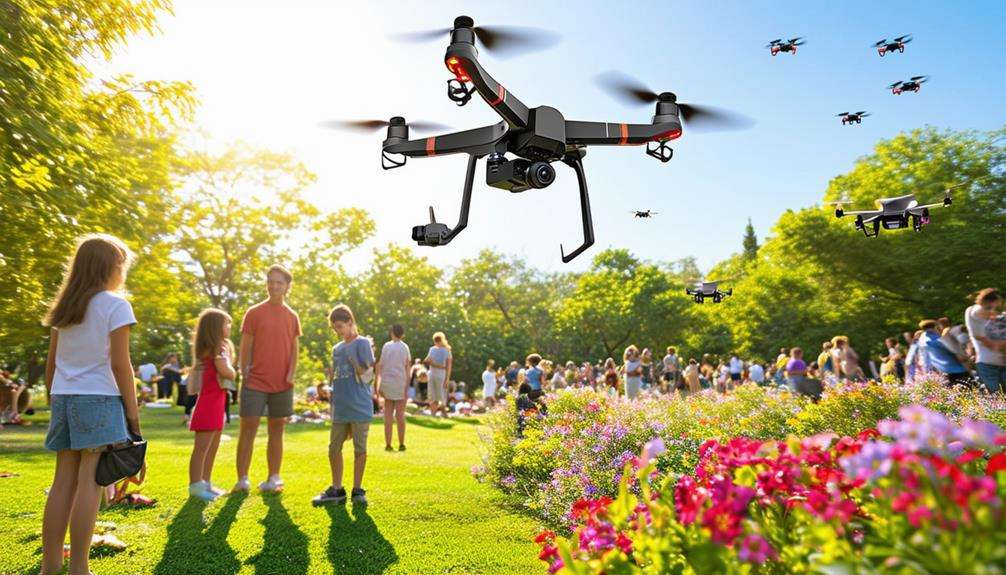
The surge in hobbyist drone popularity began in the early 2010s when affordable, user-friendly consumer drones hit the market. This made it easier for enthusiasts to dive into the world of drones, leading to a vibrant culture of recreational pilots. Many of these hobbyists use their drones for aerial photography and videography, capturing unique perspectives from the sky.
Drone enthusiasts quickly formed communities and clubs to share tips, experiences, and best practices. These groups became hubs for exchanging knowledge and fostering camaraderie. Additionally, drone racing emerged as an exciting sport, with pilots customizing their drones for speed and agility to compete in high-stakes races.
Manufacturers like DJI played a crucial role in revolutionizing the consumer drone market, offering advanced features that made drones more accessible and exciting for hobbyists.
Whether capturing stunning landscapes or participating in adrenaline-pumping drone racing, the hobbyist drone scene has something for everyone. The growing popularity of drones has transformed them from niche gadgets into mainstream recreational tools, uniting enthusiasts worldwide.
Modern Commercial Applications
With the FAA's issuance of the initial commercial drone permits in 2006, businesses and professionals began exploring innovative ways to integrate drones into their operations. This pivotal moment opened up a world of opportunities that have since transformed various industries. Drones have become essential for enhancing operational efficiency and providing detailed data collection.
Consider the following emotional drivers for adopting commercial drones:
- Innovation: Witnessing drones revolutionize traditional practices can spark enthusiasm for technological advancement and modernization.
- Efficiency: Observing streamlined operations and increased productivity thanks to drones can evoke a sense of accomplishment and progress.
- Sustainability: Recognizing that drones aid in environmental monitoring and conservation efforts can instill pride in contributing to a greener planet.
Industries such as agriculture, mining, and energy have embraced drones for tasks like crop monitoring, inspecting oil rigs, and evaluating wind farms. Drones also play a crucial role in delivery and transportation services, which are rapidly expanding sectors.
By leveraging these unmanned aerial vehicles, businesses can ensure timely deliveries and efficient transportation solutions. Environmental monitoring has also greatly benefited from drones, allowing for detailed analysis and real-time data collection. As drone technology continues to evolve, its commercial applications will surely expand, creating even more opportunities for innovation and efficiency.
Future Prospects of Drones
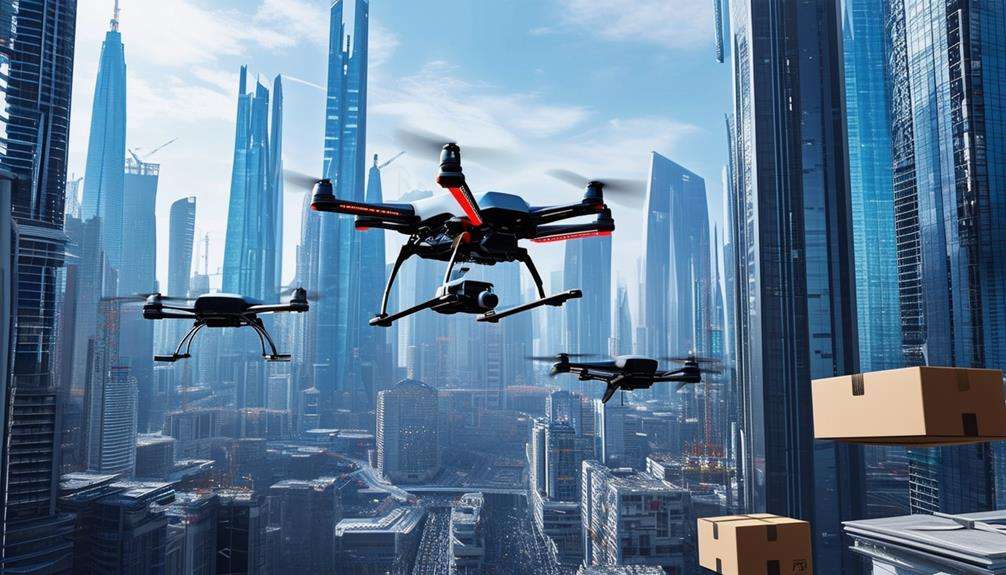
The future of drones promises groundbreaking advancements that will revolutionize diverse industries and redefine operational capabilities. The commercial sector is poised for significant growth in drone usage over the next five years. Industries such as agriculture, oil rigs, wind farms, mining, and infrastructure maintenance will increasingly rely on drones for various tasks. This trend is supported by data and industry forecasts.
Drones are expected to become integral to operations management and environmental monitoring. They offer the ability to manage large-scale operations with real-time data and precision, bringing efficiency and accuracy to workflows. Environmental monitoring will also benefit, providing tools to track changes and make informed decisions.
Delivery services are set to incorporate drones, revolutionizing logistics and transportation. This will enable faster delivery times and reduce logistical challenges, opening up new business opportunities across multiple sectors. Embracing these changes will position industries at the forefront of innovation and growth.
Conclusion
Drones have evolved from military tools to essential assets across various industries. Their transition from World War I innovations to modern commercial applications is remarkable. No longer confined to battlefields, drones are now transforming agriculture, delivery services, and environmental monitoring. As technology advances, drones are expected to play an even more significant role in daily life, making the skies busier and more innovative.

